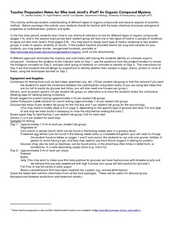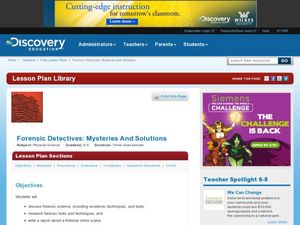Curated OER
Who Did It?
Students apply the concepts from forensic science lessons to do a lab. They solve a mystery using experimentation and observation. They write a technically correct lab report.
Curated OER
DNA AND BLOOD TYPING
Students list three descriptive characteristics and three functions of DNA, describe two ways that genetics is important in a forensic investigation, and list the four major human blood types.
Curated OER
Hair Test
In this forensic science worksheet, students write an essay about 3 open response questions presented about hair evidence shown on the photo.
Curated OER
Guide to Reading Prints
For this forensic science worksheet, students read a guide to analyzing fingerprint evidence and answer 3 short answer questions about it.
Curated OER
Hair Test
In this forensic science worksheet, students write an open response to 3 short answer questions on hair evidence collected at the crime scene.
Curated OER
Hair Test
In this forensic science instructional activity, high schoolers write an open response to 1 question on hair evidence photo taken from the crime scene.
Curated OER
Fingerprint Identification 1
In this forensic science worksheet, students classify 8 fingerprint marks according to the correct type. They also identify the unique ridges on 2 prints.
Curated OER
Fingerprint Identification 2
In this forensic science worksheet, students examine and identify the fingerprint pattern of 12 fingerprint samples. They classify them as arch, whorl or loop.
Curated OER
Fingerprint Identification 3
In this forensic science worksheet, students identify 12 fingerprint marks. They classify them according to the pattern made.
Curated OER
Fingerprint Identification 4
For this forensic science worksheet, students identify 16 fingerprints according to its type. They classify them as either whorl, loop or arch.
Curated OER
Hair Test
In this forensic science worksheet, students write an open response to 1 question about hair evidence collected from the crime scene.
Curated OER
Hair Test
In this forensic science worksheet, students write an open response to 2 questions about a picture of hair evidence collected from the crime scene.
Curated OER
Hair Test
In this forensic science worksheet, students write an answer to 1 open response question about a given hair evidence collected from the crime scene.
Curated OER
Hair Test
For this forensic science worksheet, students write an open response to 3 questions posed about hair evidence in the crime scene. They explain where and why the samples are most likely found.
Curated OER
Confectionary Bureau of Investigations: Case of the Cookie Mystery
Students perform tests on different chemicals to determine their chemical properties. In this forensic science lesson, students identify an unknown sample using its physical and chemical properties. They solve a fictional crime using...
Curated OER
Who Took Jerell's iPod?
Students investigate various substances to determine the perpetrator of a crime. In this biology lesson, students test for the presence of organic compounds in various samples. They identify an unknown substance based on its physical and...
Curated OER
Using Blood Tests to Identify Babies and Criminals
Students solve a crime by matching a suspect's blood type to physical evidence collected at the crime scene. For this forensic science lesson, students identify the different blood types. They explain how blood tests work.
Curated OER
Careers in Chemistry
Students watch a video about careers in chemistry. In this Chemistry lesson plan, students will research chemistry careers and chose one to do further research on.
Curated OER
Forensic Detectives: Mysteries and Solutions
Students examine forensic science. In this video based instructional activity, students examine the tools and techniques of forensic science. They write a report about a fictional crime scene from the Discovery video.
Curated OER
Textual Analysis: Forensic Science Files: Handwriting Analysis
Learn to analyze handwriting samples in a textual analysis lesson. Middle schoolers complete a textual analysis procedure based on the text Sammy Keyes and the Hotel Thief. They also provide supporting evidence for their work.
Curated OER
Forensic Detectives: Chemistry at Work
Students examine the different careers associated with chemistry and see how it is used everyday. In this forensic lesson students research a chemistry related career and write a presentation to give to the class.
Curated OER
Forensics: Who Killed the Iceman?
Students explore how archaeologist examine mummies. In this research based lesson, students work in groups to research two mummies and report their findings to the class through role-playing and using a model of the mummy.
Curated OER
Writing As Criminal Evidence
Young scholars research 2 famous forgery cases. In this forensics lesson, students are introduced to the methods of handwriting and paper analysis. They then use the Internet to study the cases of the Lindbergh baby and Howard Hughes'...
Curated OER
"Bio-what????"
Students work in groups to research biometric devices and present their work to the class. For this biometrics lesson, students use a handout to guide their research on a biometric device. They give group oral presentations and answer...

























